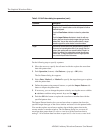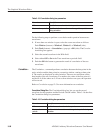
The Graphical Waveform Editor
AWG610 Arbitrary Waveform Generator User Manual
3-63
values of the points on the waveform or waveforms for input, and performs the
operation, point by point, to generate the results.
NOTE. If you perform a math operation that needs to create a new window, and
there are three windows already open, the math command displays an error
message.
If a math operation creates a waveform with values greater than ±1.0, you can
use the Zoom/Pan (bottom) commands to view the part of waveform that lies
outside the window. The instrument retains the calculated values even if they
exceed the current editor settings. Use the Normalize command to scale the
signal values to a ±1.0 DAC range.
For Dual Waveform Math, there may be a mismatch between the data lengths of
the two input waveforms. The output waveform’s data length will equal the
shorter of the two compared waveforms.
Table 3–13 lists the waveform math commands along with the equation used to
calculate the new waveform data. Information regarding more complicated
commands follow Table 3–13.
Table 3-13: Mathematical function commands
Command Equation
1
Description
Absolute
G(x) = | F1(x) | Creates a new waveform that is the absolute
value of the points in the source waveform.
Square
G(x) = ( F1(x) )
2
:Xy 0
G(x) = - ( F1(x) )
2
:X<0
Creates a new waveform that is the squared
value of the points in the source waveform.
Cube
G(x) = ( F(x) )
3
Creates a new waveform that is the cubed value
of the points in the source waveform.
Square Root
G(x) = | F1(x) | : X y 0
G(x)=- |F1(x)|:X<0
Ǹ
Ǹ
Creates a new waveform that is the square root
value of the points in the source waveform.
Normalize
Scales the active editor window signal values to
a ±1.0 range, centered on 0. This command
makes changes to the active editor window data
values.
Differential
G(x) = d/dx F1(x) Creates a new waveform that is the differentiĆ
ation of the points in the source waveform. Refer
to page F-1 for the differentiation algorithm.
Integral
G(x) = s F1(x)
Creates a new waveform that is the integral
value of the points in the source waveform. Refer
to page F-3 for the integration algorithm.


















